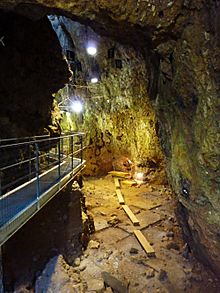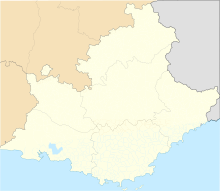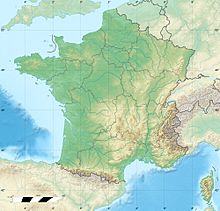Grotte du Lazaret facts for kids
|
Grotte du Lazaret
|
|
 |
|
| Location | Nice town |
|---|---|
| Region | Alpes-Maritimes Department, France |
| Coordinates | 43°41′24″N 7°17′24″E / 43.69000°N 7.29000°E |
| Site notes | |
| Excavation dates | 1962 |
The Grotte du Lazaret (which means Cave of Le Lazaret in English) is an amazing cave site. It's located in the eastern part of Nice, a town in France. This cave overlooks the beautiful Mediterranean Sea.
Scientists study this cave to learn about how prehistoric humans lived there a very long time ago. They have found more than 20,000 pieces of fossilized animal bones inside!
They also found skull pieces from a nine-year-old child. These pieces are about 200,000 years old. They suggest that early humans, like Homo heidelbergensis or early Neanderthals, once lived in the cave.
Discovering Lazaret Cave
Scientists have been digging in the Grotte du Lazaret since 1962. They found layers of dirt and rock that show when people lived there. These layers date back to a time between 186,000 and 127,000 years ago.
The finds suggest that these early humans were very clever. They might have built shelters and organized their living spaces.
An Ancient Home?
Near the entrance of the cave, along one wall, archaeologists found many Acheulean stone tools. These tools were used by early humans. They also found animal bones around two spots with lots of charcoal. These charcoal spots were likely hearths, or ancient fireplaces.
This living area was about 11 meters (36 feet) long and 3.5 meters (11.5 feet) wide. The cave wall formed three sides of this space. The fourth side was a curved line of large stones.
Scientists think these stones were used to hold up poles for a tent. This tent was probably made of animal skins and leaned against the cave wall. The tent poles and skins are long gone, but the stones remain.
They found small stone flakes and animal bones spilling out from between the stones. These spots might have been the entrances to the shelter.
Clues from the Past
Near the ancient fireplaces, tiny sea shells were found. These shells might mean that seaweed was brought into the cave. Perhaps it was used as soft bedding!
This suggests that the early humans had different areas for different activities. There might have been an inner area for sleeping and an outer area under the tent for other tasks.
It's not 100% certain that humans placed all the stones. Natural events could have moved them, or they might have been there for another reason. But the evidence at Grotte du Lazaret is stronger than at other similar sites.
For example, at places like La Baume Bonne and Orgnac Cave, similar tools were found near natural rocks. But the clues for a built shelter are not as clear there. It's hard to find strong proof of homes built before modern humans arrived about 50,000 years ago. Simple structures from so long ago often don't leave clear traces.



